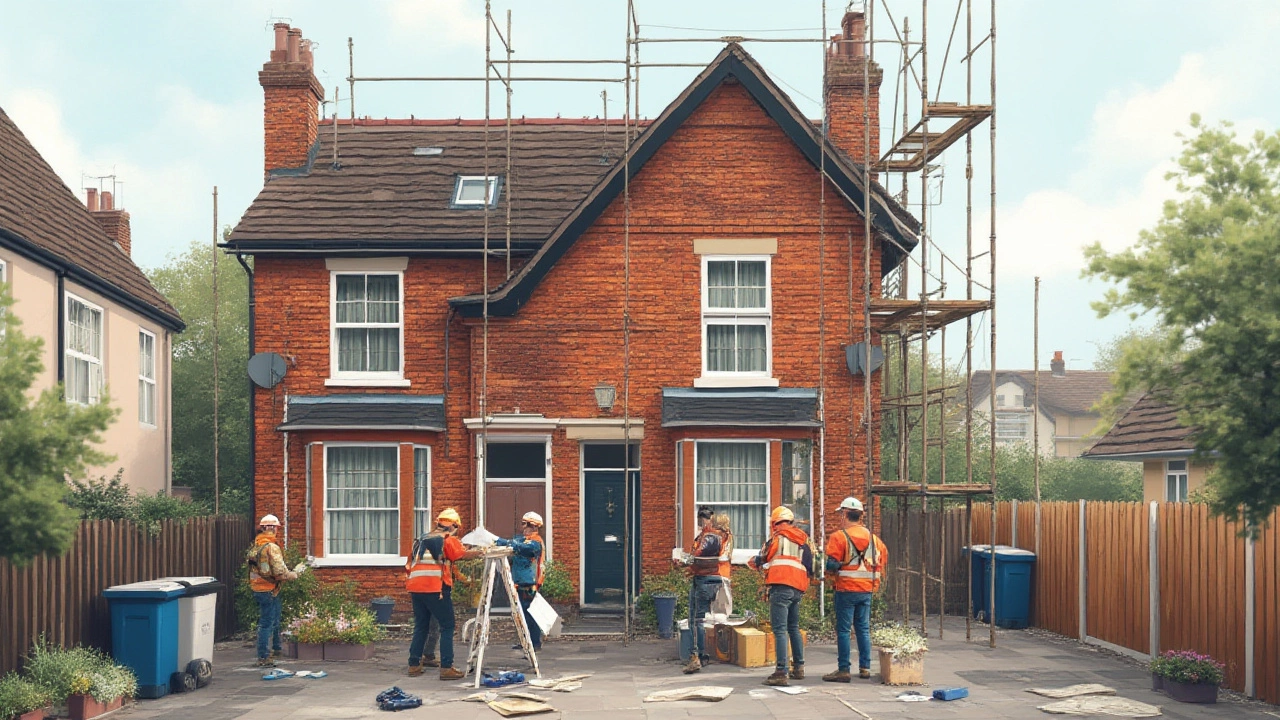Imagine a sudden leak turning your cosy living room into a paddling pool, all because your roof finally caved in. Replacing a roof can leave your wallet looking a lot like your old tiles: full of holes. Not many homeowners wake up in the morning with a plan or saving jar for a new roof. So, when you hear the words ‘roof payment’ for the first time, it might sound as mysterious as those noises you hear in the attic at night.
What Exactly is a Roof Payment?
Let’s clear up the confusion straight away. A roof payment isn’t a special cheque you send to your roofer in an envelope marked ‘top secret’. It’s the cost you pay—sometimes all at once, sometimes in parts—when you need a new roof or repairs to the existing one. The payment covers materials, labour, removal of old roofing, potential insulation, underlayment, and more. Most times, this payment is handled between you and the roofing contractor, and sometimes it’s partially handled by your insurance company if you’ve suffered storm or accidental damage.
The cost can vary as wildly as British weather. For a standard-sized home in England, replacing the entire roof ranges from £5,000 to £8,000, though prices in London or for complex jobs can easily hit £12,000 or more. Sometimes, you're only fixing a patch, and the price drops, but the principle is the same: you’re paying for professionals to keep your house dry and safe. That’s your roof payment.
Now, how this amount is paid depends on the contractor and what you’ve agreed upon. Most ask for a deposit upfront, usually 10–30% of the job, with the rest due on completion. Sometimes, especially for bigger jobs, you’ll pay in stages. Rarely, if ever, do professional roofers ask for the whole sum before the job begins—that’s a red flag for possible scams.
You might have insurance that covers the cost. In that case, your ‘roof payment’ may refer to your deductible: the bit insurance won’t pay. In the UK, this usually means your policy excess (say, £250 or £500). In the US, where the term is common, homeowners refer to whatever their out-of-pocket expense is after the insurance payout. Either way, the contractor gets paid, and you and your home stay dry. If you’re not using insurance, then your payment covers everything.
Banks and lenders know how common emergency repairs are. Many offer home improvement or personal loans that can be paid back over 1 to 7 years. And lots of roofing firms now partner with lenders or even offer ‘0% interest for six months’ deals to help manage the cost.
So, a ‘roof payment’ is simply what leaves your account—via cheque, transfer, or finance deal—toward keeping your roof sound and the rain outside where it belongs. It isn’t a fancy legal term, just the practical side of getting a critical job done.
How Do Roof Payments Usually Work?
When you start the journey of replacing or fixing your roof, you’ll get to know the roof payment process pretty quickly. It starts with a quote. Roofing companies almost always visit your house, measure up, and assess the job in person. Expect detailed written quotes outlining costs for materials (tiles, felt, insulation), labour, any scaffolding, skip hire, and extra options—like new gutters or skylights.
After agreeing to a quote, the contractor usually asks for a deposit. Industry standards say never pay more than 30% upfront unless there’s a special-order material involved. Any contractor pushing for total payment before starting likely isn’t legit. For major or multi-week projects, you might pay in two to three installments—deposit, mid-point, and final balance once you’ve inspected the finished job and it’s up to scratch.
Payment methods are changing. Bank transfers have almost totally replaced cash or cheques, especially in the UK. Larger firms might accept credit card payments, especially for deposits. Some offer digital invoicing, letting you pay in a couple of clicks. Always ask for receipts—your warranty and peace of mind depend on it.
If you’re using insurance, things widen out a bit. Usually, after storm or accident damage, you call your insurer, who’ll send an assessor. They agree a payout with you, pay the contractor direct, or let you pay and then reimburse what’s covered. Sometimes, the roofer deals directly with your insurer. But the key part—the roof payment itself—is usually just your excess or deductible, along with any upgrades you ask for above the basic fix (like upgrading to slate tiles). It’s very rare for insurance to cover routine wear and tear, so age-related replacements are out-of-pocket costs.
For people needing to spread payments, roofing companies often partner with lenders or offer ‘buy now, pay later’ finance. Some let you pay over 12–60 months. Of course, these deals come with interest (sometimes 7–15% APR), so check your numbers. You could also use a 0% credit card or personal loan to manage your roof payment if you have good credit. Just be sure to read the fine print and watch for extra fees.
The goal is always the same: the contractor wants to be paid, you want a dry home. The best relationships are transparent. Always clarify when payments are due, get it all in writing, and avoid any cornershop ‘handshake deals’. Give yourself a paper trail—just in case there are issues down the road.

What Factors Affect the Size of a Roof Payment?
Let’s talk brass tacks. No two roofs are alike, so your *roof payment* could look radically different from your neighbour’s, even if your houses are the same shape and size. What drives these differences?
- Material Choice: Asphalt shingles are usually cheapest; clay, slate, and metal can more than double costs. In London, slate is common for terraces; in rural Kent, clay tiles rule.
- Roof Size and Pitch: A steeper or larger roof needs more materials and time, upping the price.
- Labour: London rates for roofers top the charts—expect to pay a premium for skilled work in the city or anywhere with lots of demand.
- Access and Scaffolding: If your property is hard to reach or needs bespoke scaffolding, that can add thousands to your bill.
- Waste Removal: Dumping old tiles or lead flashing isn’t free. Most quotes bundle this in, but check to be sure.
- Extras: Things like adding insulation, new gutters, or fixing structural timber (called ‘roofline timber repair’) can add hundreds or more.
- Urgency: Emergency repairs always cost more, as contractors have to reshuffle schedules or pay workers overtime.
- Warranty and VAT: Longer workmanship warranties cost more. VAT at 20% covers all home improvement, so don’t forget this in your calculations.
If you like numbers, here’s a table with average roof replacement costs for different materials and home sizes in the UK (2024 data):
| Material | Typical Semi-detached | Average Detached |
|---|---|---|
| Asphalt Shingles | £5,000–£7,000 | £8,000–£10,000 |
| Clay Tiles | £6,500–£9,000 | £10,000–£13,500 |
| Natural Slate | £7,000–£12,000 | £13,000–£20,000 |
| Metal/Standing Seam | £10,000–£16,000 | £18,000–£25,000 |
Remember, these are averages and include labour, materials, scaffolding, and VAT. Even a simple flat roof—common on garages or dormers—averages £3,000 to £5,000 for felt or single-ply membrane replacements. So, ask for a full, honest breakdown from your roofer. Don’t be afraid to get a few quotes—and never just go for the cheapest. A suspiciously low price almost always means corners are being cut, or you’ll face nasty ‘extras’ halfway through.
Tips to Manage and Lower Your Roof Payment
The thought of shelling out thousands of pounds for a roof can make anyone sweat. But the smart money is in preparation—and a bit of negotiation. Here’s how everyday Londoners keep more cash in their pockets with roof payments.
- Always Shop Around: Get three or more quotes, ideally from local firms that come recommended. Check Trustpilot, Which?, and ask neighbours for feedback on quality and aftercare.
- Don’t Ignore Small Jobs: Fixing loose tiles or a small leak quickly—sometimes under £200—prevents big repairs piling up.
- Look for Hidden Extras: Ask for quotes that specify every detail. ‘Labour and materials’ isn’t enough—ask for itemized lists, including skip hire and scaffolding.
- Time It Right: Roofing is quieter in winter (apart from emergencies) and during school holidays. Some firms offer discounts to fill gaps in their calendar.
- Negotiate Payment Terms: Reputable contractors will often let you pay in stages—never feel pressured to hand over a lump sum until the job’s finished.
- Check for Grants: Some councils and schemes offer help for energy efficiency upgrades (like adding insulation) or repairs for vulnerable homeowners.
- Finance Smartly: If you must borrow, compare loans and 0% credit cards. Avoid payday lenders and short-term finance with big fees.
- Read the Small Print: Make sure warranties include both materials and workmanship—some last 10, even 20 years. Short guarantees can signal cheap, short-lived materials.
- Beware of Door-Knockers: Anyone pitching roof work uninvited could be running a scam. Never agree to work on the spot. Legit pros don’t cold-call like that.
One more insider tip: arrange for a ‘final signoff’ payment after you’ve checked the work and received building regs paperwork (sometimes called a completion certificate) if it’s required. That way, you only pay once everything’s truly finished to standard.

Common Questions About Roof Payments
These conversations between homeowners and roofers are surprisingly common—and worth knowing about.
- ‘Can I pay in cash?’ Most professionals prefer bank transfer or card for traceability and simplicity. Cash-only jobs can void your warranty or cause HMRC headaches.
- ‘What if a payment is late?’ Most contracts build in a little leeway, but stringing out payments can delay finishing or impact your warranty. Stay communicative if you hit a snag.
- ‘Is VAT included?’ Good quotes always include it, but always triple-check, especially if a number looks suspiciously low.
- ‘What happens if I find a problem after paying in full?’ This is where a formal contract and warranty pay off. Good roofers sort issues quickly. Less reputable ones… disappear.
- ‘Can insurance cover roof replacement?’ Only sudden storm, fire, or accidental damage—never age, general wear, or lack of maintenance.
- ‘Is a deposit always required?’ Not always, but it’s the norm when materials cost thousands. See a deposit as a sign of serious intent, but never pay more than 30% before work begins.
If your roofer goes bust or does shoddy work, you have more protection if you’ve paid by credit card (over £100, under £30,000) thanks to Section 75. Just another reason to avoid handing over cash unless there’s no alternative and you trust the person completely.
Roof payments aren’t glamorous. But a dry, solid roof is. And honestly, paying for proper work is much less stressful than sopping up the next rainstorm in your slippers.
